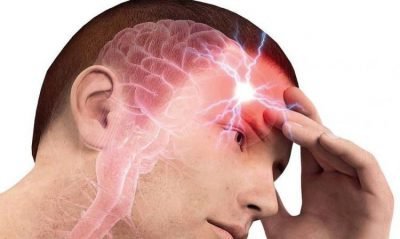Causes of neurosis in VSD
Why does neurosis occur with VSD? Doctors identify several of the most common causes:
- mental trauma, including those inflicted in childhood;
- excessive emotional and physical stress, chronic fatigue and lack of sleep;
- a tense situation in the family or at work, and the strong negative experiences it causes;
- the impossibility of resolving any situation, internal conflict within oneself;
- genetic predisposition.
The causes of vegetative-vascular dystonia are:
- Pathology of childbirth and pregnancy (hypoxia of the child, trauma).
- Stress (a common risk factor for the development of neurosis and VSD).
- Traumatic brain injuries.
- Hormonal imbalance.
- The presence of VSD in close relatives (mother, father, grandmother, grandfather, brothers or sisters).
- Climate change.
- Overwork.
- Neurotic disorders.
With dystonia, one division of the autonomic nervous system (sympathetic or parasympathetic) predominates. The development of neurosis, as one of the causes of VSD, is facilitated by:
- Personal and family problems. Neuroses often arise against the background of divorce, loss of loved ones, betrayal, change of place of work and place of residence, jealousy and financial difficulties.
- Conflict situations. They are possible in the family circle, at work or study.
- Not having your needs met.
- Lack of emotions.
- Chronic stress.
- Unfavorable production factors (bad team, delayed salaries, impossibility of career growth).
The development of this pathology is based on disruption of the brain, which makes it difficult for a person to adapt to unfavorable factors.
Autonomic dysfunction occurs due to a malfunction of the autonomic nervous system. This occurs as a consequence of mental trauma and depression. Factors that provoke pathology can be diseases that, at first glance, have nothing to do with the nervous system, for example:
- pathologies and injuries of the spine (especially in the cervical region);
- infectious damage to the body (tonsillitis);
- pathologies of the endocrine system;
- gastrointestinal diseases;
- allergy;
- frequent overwork;
- traumatic brain injuries.
Alcohol and drugs in VSD cause neuroses and worsen the patient's condition.
The occurrence of neurosis in VSD is natural, because this pathology is one of the signs of autonomic dysfunction. Its development is influenced by psychogenic factors, such as:
- mental trauma;
- genetic predisposition;
- nervous exhaustion due to constant mental or emotional stress;
- addiction to alcohol and drugs;
- chronic fatigue, insufficient rest;
- strong feelings due to problems in the family or at work, conflicts with loved ones, etc.;
- inability to resolve the current difficult situation;
- diseases that reduce immunity.
Having discovered neurotic disorders in themselves, people, before starting therapy and treatment of dystonia, wonder where this disorder in the functioning of the nervous system, complicated by VSD, could have come from.
Considering neurosis as a pathology that causes fear of death, characteristic of dystonia, the following causes of occurrence can be attributed to it:
- heredity;
- constant emotional tension;
- chronic stress;
- lack of night rest;
- food that does not have a balanced composition;
- constant stress, both mental and physical;
- bad habits;
- suffered TBI;
- infectious diseases;
- imbalance at hormonal levels;
- decrease in the body's defenses;
- vitamin deficiency.
To prescribe adequate therapy, a detailed study of the patient’s lifestyle, his eating habits, lifestyle and field of activity is required. Knowing all these features, a specialist can make a diagnosis and prescribe the necessary treatment. To get rid of neurosis, first of all, vitamin therapy is indicated, as well as symptomatic treatment of the most disturbing manifestations.
How to treat pathology?
Neurosis must be treated comprehensively. But first you need to undergo an examination to confirm the diagnosis. After this, the doctor selects individual treatment based on the specific character of the patient and the course of the disease. Drug therapy is used as a last resort; psychotherapy is often sufficient. To completely get rid of the problem, you need to follow all the recommendations of your doctor.
Drug therapy
In the case of drug treatment, the patient is prescribed a set of drugs aimed at eliminating the manifestations of the disease and its cause, as well as restoring and strengthening the nervous system. Violation of the dosage specified in the prescription or self-medication leads to serious complications, more severe than VSD. As part of treatment, the patient is prescribed drugs of several groups:
- Neuroprotectors. medications in this group improve cerebral circulation and have antioxidant properties, thereby protecting nervous tissue from the negative effects of the environment.
- Sedatives. They have a positive effect on the central nervous system. Overdose leads to dangerous complications, including death.
- Antidepressants. Such medications eliminate insomnia and anxiety.
- Beta blockers. Used to support the heart and blood vessels, normalize blood pressure and heartbeat.
Return to contents
Physiotherapy
This type of treatment involves carrying out certain procedures that normalize blood circulation, allowing a person to relax and calm down. One or more remedies are used at once, but they must be prescribed by a specialist. Self-medication (even a contrast shower) can provoke a worsening of the condition. The most effective means of physiotherapy are:
- massage (especially in the neck and lower back);
- acupuncture;
- electrophoresis of the cervical region;
- water procedures;
- breathing exercises using special equipment.
Return to contents
Psychotherapy
Not every patient guesses from what period the development of neurosis and VSD began. According to experts, these pathologies develop as a result of mental stress and mental trauma. In this case, medications will not have the desired effect, psychotherapy is required. Using one of the methods (conversation, imitation of a frightening situation), the patient is able to identify the cause of the disease, stop being afraid of the past or future, and control his emotions.
Physiotherapy
Sport normalizes the state of the nervous system.
Any physical exercise has a beneficial effect on the state of the nervous and cardiovascular systems. Walks in the park, going out of town, fitness, running, race walking, gymnastics for VSD are a good solution for combating neurosis and eliminating its manifestations. At the same time, you should not engage in sports that require sudden movements, jumping and are accompanied by excessive physical activity. To begin with, it is recommended to do exercises every day in the morning and master breathing exercises. Swimming gives good results.
ethnoscience
Traditional medicine is used as part of complex treatment. The use of herbal infusions helps strengthen and restore the nervous system and eliminate signs of pathology. The most popular fees are:
- Take 1 part each of valerian, chamomile, mint, fennel, lily of the valley flowers and mix. 2 tbsp. l. Infuse the collection in 1 liter of water at room temperature. Take 50 ml before meals.
- Take 2 tbsp. l. collection of chicory root, licorice, volodoshka, St. John's wort, valerian and juniper, pour 1 liter of hot water and let it brew for 24 hours. Drink 150 ml infusion before meals.
In addition to using herbal infusions, you should adjust your diet. It is important to get all the necessary vitamins. It is recommended to add dried fruits, nuts, honey, fresh vegetables and fruits to your diet. You should avoid foods that are too fatty and fast, as well as carbonated drinks. They should be replaced with juices, berry fruit drinks and still water.
Features of vegetative-vascular dystonia

VSD is a disorder associated with dysfunctions of the human psyche and autonomic nervous system. This system is responsible for the functioning of all our organs, for body temperature and blood pressure, maintains them in a normal state and regulates the body's reactions to external factors. Therefore, disruption of the functioning of the autonomic nervous system leads to various problems and deterioration in overall health.
The diagnosis of VSD is usually made when doctors cannot determine the real cause of disorders in the human body and it is impossible to comprehensively consider the problems that patients complain about. As a traditional approach to the treatment of vegetative-vascular dystonia, patients are usually prescribed various sedatives and vascular drugs that do not cure, but provide only temporary relief.
Symptoms
There are many symptoms of VSD, so it is impossible to immediately diagnose this disease; it all depends on the age of the patient. Children are capricious, restless, sleep poorly, often burp after eating and catch colds, and they also have noticeable intestinal dysfunction. In adolescence, symptoms of VSD may include shortness of breath, problems with blood pressure, rapid heartbeat, mental disorders, etc.
Reasons for appearance
Vegetovascular dystonia usually forms during the development process of the embryo or in infancy. When pregnancy or childbirth had complications, if the child was infected during breastfeeding or at an older age, then there is a high probability that in the future the person will be diagnosed with VSD. In addition, there are other reasons for the appearance of this disease:
- genetic predisposition;
- structural features of the body;
- abnormal development of internal organs;
- hormonal imbalance in childhood or adolescence;
- frequent stress, prolonged depression, severe emotional shock;
- physical overload.
Poor health, frequent illnesses in childhood and rapid growth in adolescence also provoke the appearance of VSD. When a teenager’s physical development proceeds faster than expected, disturbances in the functioning of his body appear, since the autonomic system develops more slowly. As a result, mental and physical problems appear, which may indicate the presence of vegetative-vascular dystonia.
VSD is a pathology in which neurotic disorders develop quite clearly. Vascular dysfunction, characterized by vascular spasm, causes tension in muscle fibers and nutrient deficiency in the brain.

Neurosis is a disease that occurs in the form of a dystonic disorder and occurs as a result of a person being in a stressful situation for a long time. There is no point in treating vegetative-vascular pathology if there are additional problems with the nervous system. Only after eliminating the neurosis can you begin to treat the underlying pathology, otherwise it will be very difficult to achieve a positive result.
- emotional swings;
- anxiety;
- fears that have no basis;
- anxiety states;
- fear of open space or large crowds of people;
- disturbances in mental activity and memory;
- high sensitivity;
- constant bad mood;
- fear of sharp sounds;
- decreased libido.
In addition to purely emotional components, a person may be bothered by the following physical manifestations:
- headaches that last for a long time;
- changes in the normal heart rate;
- weakening of muscle strength;
- disorders of the gastrointestinal tract;
- decreased ability to coordinate movements.
As you can see, the symptoms of dystonia and neurosis are quite varied. Their treatment should be handled by a therapist who, if the need arises, will refer the patient for consultation to specialized specialists.
Vascular spasms during neurosis
Spasm of the blood vessels of the heart is considered a sharp and sudden narrowing of the lumen of the arteries, more precisely, the smooth muscle tissue that lines them. This tissue regulates blood flow in the coronary arteries. Such a spasm is temporary, however, it occurs in the form of angina pectoris, causing a person considerable discomfort.
- Causes
- Symptoms
- Diagnostics
- Treatment
- Consequences and prevention
A form of coronary insufficiency in which spasm leads to chest pain that occurs during rest is called resting angina. It is more common among women, even young ones. This condition may not depend on damage to the coronary arteries by the pathological process. Rest angina is less likely to cause severe complications or death than the usual form of the disease.
Sudden narrowing of the lumen of the arteries of the heart
The etiology of spasms of the heart vessels is not fully understood. Some factors influencing its development, experts include increased activity of platelets, which are responsible for blood clotting. Of course, there are other reasons, which we will look at later. Regardless, any spasm is preceded by a calcium influx into the smooth muscle cells that line the arteries.
There is also such a thing as capillary angina. This syndrome predominantly affects women.
In this case, characteristic changes are observed on the ECG, but the coronary arteries are not blocked, and there are no signs of oxygen starvation of the heart muscle during stress or sports activities.
There are opinions that this form of spasms occurs as a result of impaired functioning of small vessels that are located near the coronary arteries.
Causes
Despite all of the above, it is possible to identify certain causes that lead to spasm and, accordingly, cause an attack of angina.
One of the causes of spasms is vascular atherosclerosis
- Atherosclerosis. Spasm and angina attacks occur when the lumen of the coronary arteries is narrowed by 50-70%. The more pronounced the stenosis, the more severe the course of the disease. The severity of attacks depends on the location and extent of the stenosis, as well as on the number of affected vessels.
- Gastrointestinal diseases.
- Infectious and allergic diseases.
- Rheumatoid and syphilitic vascular lesions.
In addition, it is possible to distinguish between removable and irreparable causes of spasm.
- Avoidable factors: hyperlipidemia, obesity, physical inactivity, smoking, diabetes mellitus, arterial hypertension, intoxication and anemia, psycho-emotional stress, increased blood viscosity, exposure to cold, the use of certain medications. Smoking increases the concentration of carboxyhemoglobin in the blood. This is a combination of hemoglobin and carbon monoxide, causing oxygen starvation of cells and spasm of the arteries.
- Unavoidable factors: age, gender, heredity.
Symptoms
The clinical sign is characterized by pressing or squeezing pain that occurs behind the sternum and radiates to the left shoulder blade or arm. Most often it occurs during emotional or physical stress, however, as we learned above, it can also occur at rest.
The threshold for the development of pain is determined by the degree of damage to the coronary arteries. If there is severe damage to three coronary arteries, spasm will occur even under minimal load. Angina at rest occurs mainly at night.
Attacks of this form of angina are longer and more intense. The pain increases more slowly than it disappears. It may be accompanied by the following symptoms:
- nausea;
- sweating;
- lack of air;
- dizziness;
- heartbeat.
As we already know, angina takes different forms, which are caused by spasm of the heart vessels, so it is worth recalling the classification of angina.
Angina pectoris. It is characterized by transient pain in the chest. They are caused by physical or emotional stress, which increases the metabolic demands of the heart muscle.
In this case, the pain disappears when taking nitroglycerin or at rest. Angina pectoris includes several types. For example, a spasm that occurs for the first time, that is, angina, lasts about one month or less from the first manifestation.
The prognosis and course are different, so this form may develop into another.
Stable angina lasts more than one month. It includes four functional classes. The first class is characterized by an attack that develops with excessive loads performed for a long time and intensively. In the second class, physical activity is limited, an attack occurs when climbing more than one floor and when walking more than 500 meters.
This usually occurs during bad weather and emotional excitement. In the third functional class, an attack occurs when climbing one floor and walking less than 200 meters. The fourth functional class is characterized by sharply reduced physical activity and the development of seizures at rest.
Spontaneous angina. It is caused only by a sudden spasm of the heart arteries. Attacks occur only at rest, early in the morning or at night.
Diagnostics
In order to recognize angina pectoris and the causes of spasm, it is necessary to carefully consider the patient’s complaints, namely the location, nature and duration of pain, as well as the conditions of their occurrence. It is important to conduct laboratory diagnostics. It includes blood tests for cholesterol, lipoproteins, triglycerides, electrolytes, and so on.
It is very important to determine cardiac troponin T and I markers, which indicate myocardial damage. It is very important to identify the cause of spasms and understand how they lead to angina attacks.
A number of other examinations should also be carried out.
- ECG. If the ECG is taken at the height of the attack, a decrease in the ST interval will be observed. A negative T wave will be noted in the precordial leads. Rhythm and conduction abnormalities will also be present.
- Daily ECG monitoring. Using this method, ischemic changes, if any, can be determined. Before an attack, the heart rate increases. In the case when the heart rate is normal, they speak of spontaneous angina caused by spasm of the heart vessels.
- EchoCG. With angina pectoris, ischemic local changes are detected.
- Bicycle ergometry. This is a test that shows what maximum load the patient can withstand. The load is created by the exercise bike until the submaximal heart rate is reached. At this time, an ECG is recorded.
- Diagnostic coronary angiography. It is carried out in order to assess the degree, location and extent of arterial damage.
All the results obtained from these examinations make it possible to distinguish spasms of the heart vessels from other diseases and understand their causes.
Consequences and prevention
Spasm leading to the development of angina pectoris significantly increases the risk of myocardial infarction. The most dangerous thing that can happen is death. That is why it is necessary to be examined in time and pay attention to any symptoms. It is also very important to prevent spasms and the development of angina pectoris.
Basic methods of prevention:
- to give up smoking;
- blood pressure control;
- limiting physical and emotional stress;
- limiting the consumption of alcoholic beverages;
- proper nutrition;
- moderate physical activity.
By following these simple rules, you can avoid problems not only with blood vessels, but also with other organs. Let's not forget that most often our health is in our hands!
Source: https://prososudy.com/sosud/spazmy-sosudov-pri-nevroze.html
Clinical picture
Manifestations and symptoms of neurosis are similar to the signs characteristic of VSD. Among other things, sick people often experience:
- heart failure;
- increased blood pressure;
- increased level of anxiety;
- weakness, expressed by vascular neurosis;
- high fatigue;
- problems with sleep and appetite.
Various symptoms of neurosis appear, both independently and as a sign of VSD. Among them, a special place is occupied by the following symptoms of VSD:
- occasional suicidal thoughts;
- anxiety, manifested in constant restlessness;
- a feeling of “goosebumps” running throughout the body;
- increased urination;
- chest pain;
- difficulty breathing.
All these manifestations may well be signs of diseases of the respiratory, nervous, cardiovascular or gastrointestinal systems. To clarify the diagnosis, an examination is required, during which the person passes all the necessary tests.
The clinical picture of neurosis is manifested by symptoms of a somatic and mental nature
It is difficult to list absolutely all the symptoms of VSD and neurosis, since there are a great many of them, among them:
- increased anxiety;
- general weakness and increased fatigue;
- panic attacks;
- poor appetite;
- sleep disorders;
- paresthesia (unusual sensations in the body, for example, “crawling” goosebumps, etc.);
- urinary disorders;
- decreased libido;
- headaches (in the absence of any pathology);
- discomfort from the digestive system (if there are no diseases);
- pain or discomfort in the chest (only if heart and vascular diseases are excluded!);
- feeling of lack of air (in the absence of pathologies of the cardiovascular and respiratory systems).
All of the above symptoms are also accompanied by other manifestations of the autonomic nervous system, namely increased sweating, accelerated heartbeat, etc.
We will identify the symptoms of psychoneurosis and signs of a neurotic disorder - CMZ "Alliance"
The signs of a neurotic disorder are variable and imprecise; each person’s neurosis can manifest itself differently. Therefore, in order to accurately establish a diagnosis and receive adequate treatment, you need to consult a psychotherapist.
Important
A psychotherapist diagnoses neurosis. The treatment regimen that will help cope with the disorder depends on the type of neurosis and its severity.
Neurosis is a functional disease of the nervous system. This means that the disorder occurs temporarily; there is no infection, tumor, or persistent pathology of blood vessels or internal organs in the body. Negative factors deplete the nervous system:
- stress;
- overvoltage;
- internal conflict;
- traumatic situation.
This causes disturbances in the functioning of the heart and blood vessels, indigestion, strange pain and discomfort in different parts of the body. Somatologists (who deal with diseases of the body - therapists, neurologists) do not find any abnormalities: neither peptic ulcers, nor abnormalities of the endocrine system (for example, the thyroid gland), nor inflammation.
Manifestations of neurosis in adults are often confused with other diseases, so most patients undergo examinations for years, but treatment does not produce results. In such cases, it is recommended to consult a psychotherapist.
The body is healthy with neurosis, most tests are normal. “All diseases come from nerves” - that’s exactly what it’s about.
How to recognize neurosis? It is characterized by the following symptoms:
- somatic manifestations (from the body) - vague pain, increased fatigue, changes in blood pressure, fever, sweating;
- emotional instability - frequent unreasonable or causeless anxiety, fear, irritability, tearfulness;
- poor load tolerance - a person cannot concentrate, sometimes cannot sit still. Both work and personal life suffer; basic tasks become tiresome very quickly.
In the next part we will take a closer look at how neurosis manifests itself and what specific symptoms and complaints are possible.
How to define neurosis
Symptoms depend on the form of neurosis. The most common manifestations of the body and psyche are:
- sleep disorders;
- indigestion;
- breathing problems, feeling of suffocation;
- disruption of the heart and blood vessels;
- vegetative symptoms - trembling, convulsions, sweating, temperature changes, even pain.
One of the first possible signals is sleep disturbances. Difficulty falling asleep, shallow or restless sleep, frequent awakenings. The feeling of tension in the head during neurosis is a consequence of the fact that at night the nervous system is not fully restored. Sleep disorders lead to constant tension and emotional breakdowns.
The digestive system is sensitive to psychological traumatic factors. She reacts with loss of appetite, flatulence, frequent pain and discomfort in the abdomen, and problems with stool. In this case, the person has neither an ulcer nor an intestinal infection. A common manifestation is nausea during neurosis, which is accompanied by a feeling of dry mouth.
Important
The nervous system is connected to all internal organs, so with neurosis the entire body suffers. The opposite is also true: if you give a specialist the opportunity to cure the psyche, the physical symptoms will also disappear.
With neuroses, there are breathing problems: typical complaints are lack of air, difficulty inhaling or exhaling, and suffocation. Sometimes a person feels like he has forgotten how to breathe. It is often observed when you find yourself in a conflict or emotionally significant situation.
From the cardiovascular system, hypertensive crises, heart rhythm disturbances, and discomfort in the chest area may be observed. Tachycardia with neurosis is a common complaint.
The nervous system takes the main “blow” under constant stress. A person experiences tremors in the body during neurosis, frequent headaches, hot flashes, muscle cramps, changes in sensitivity (numbness of the limbs). Sometimes he may complain that he feels dizzy for no reason.
All changes in neurosis are functional, that is, reversible. With adequate treatment, patients recover completely.
Mentally, a person becomes depressed, cannot concentrate for a long time, and memory decreases. The level of anxiety increases, and overly violent emotional reactions are possible. With psychoneuroses, there are no hallucinations, but sometimes there is tinnitus.
If it is necessary to sit quietly for some time, a person with neurosis experiences discomfort. To calm himself down, he begins to tap his pen, play with an item of clothing, and fidget with his fingers.
Psychoneurosis: symptoms and reasons for contacting a specialist
Frequent suppression of negative emotions and life in constant stress lead to prolonged psychoneuroses. It can be extremely difficult to get out of them without qualified help.
A person can be tormented for years by chronic neurosis, the symptoms of which are emotional “breakdowns” (hysterics, tears, irritability) or physiological reactions (stupor, loss of voice, pressure surge, nausea) to a small conflict or difficulty. A person is simply not able to control behavior and emotions at a difficult moment.
Important
If a therapist, cardiologist, or gastroenterologist did not find anything, do not forget to seek a diagnosis from a psychotherapist.
Often, in attempts to alleviate the condition or find out the cause of constant discomfort, people find imaginary illnesses due to neuroses. This is characteristic of the somatoform form of the disorder.
A person undergoes all possible tests and undergoes absolutely all examinations.
The burning sensation of the skin or weakness in the legs (sometimes even the slightest sensation in the body) characteristic in some cases of psychoneurosis is perceived as a symptom of a terrible, fatal disease.
This disease is reversible, but contacting a psychotherapist is an important step on the path to recovery. A neurotic disorder worsens relationships with family, creates problems at work, and leads to self-destructive behavior (alcohol, drugs, attempts to die).
The reason for contacting a specialist may be a violation of the thermoregulatory function of the body - simply put, an increase in temperature due to neurosis. In another way it is called thermoneurosis. Here it is important to exclude other diseases, so you can also consult a neurologist.
Dizziness due to neurosis, interruptions in heart function, increased fatigue and other symptoms are a reason to be examined by a doctor.
Diagnostics includes:
- A personal conversation between the doctor and the patient is the first and most important stage, on which the plan for further action depends.
- Consultation with a neurologist - if neurological disorders are suspected (numbness, pain, fever, impaired mobility).
- For differential diagnosis, the doctor may prescribe Neurotest and Neurophysiological test system (with endogenous diseases), EEG, CT/MRI, blood tests for hormones and markers (indicators) of inflammation.
- If necessary, the doctor involves a clinical psychologist or scientific experts in the diagnosis, and may convene a consultation.
Based on the diagnostic results obtained and the patient’s medical history, the psychotherapist prescribes appropriate individual treatment. Read more about the treatment of neuroses.
Prices for services
| Initial appointment with a psychotherapist | 5,000 rub. |
| Consultation with deputy Head of the Center | 7,000 rub. |
| Consultation with professor, doctor of medical sciences | 7,000 rub. |
| Appointment with a neurologist | 4,000 rub. |
Source: https://cmzmedical.ru/zabolevaniya/nevroticheskie-rasstroystva/diagnostika/
Types of neuroses

With vegetative-vascular dystonia, several types of neurotic conditions are usually distinguished:
- Depressive neurosis. In this case, patients’ interest in life becomes dull, they feel joyless, tired, and don’t want anything. This type of neurosis can be difficult to get rid of even with the help of a professional.
Neurotic depression
- Obsessive-compulsive disorder (psychasthenia). With this neurosis, for some reason a person systematically performs “extra” and “unnecessary” actions, for example, jerking his leg, fingering his hair.
- Asthenic neurosis (neurasthenia). Such patients have increased fatigue, they feel weak and drowsy, and have an increased need for rest. There are sudden mood swings from excessive irritability to complete indifference.
- Hysterical neurosis. Episodes of emotional outbursts predominate. In this case, the patient loses control over himself. Seizures may be complicated by paralysis, convulsions, or even hallucinations. The degree of self-suggestion matters. Women most often suffer from hysterics.
Further on how to defeat neurosis and VSD. In order to break the vicious circle
Treatment of VSD and neurosis
VSD, neurosis and other unpleasant manifestations of imbalance in the functioning of the nervous system can cause panic attacks and, in general, interfere with a person’s normal life.
As means that can reduce the manifestations of neurosis, the attending physician often prescribes the following drugs:
- neuroprotectors that lead to normal blood circulation in the brain (for example, the effectiveness of the drug Phenibut for VSD has been clinically proven); sedatives that sedate the excited nervous system (their use must be carried out with strict adherence to the dosage so as not to cause the development of adverse reactions from the body);
- antidepressants to treat autonomic disorders manifested as sleep problems or the development of anxiety;
- beta-blockers, normalizing blood pressure and heart rate.
In addition to medicinal effects, in the treatment of neurosis with VSD, the following measures are important:
- physical therapy exercises (properly performed exercises, gymnastics, eliminate vegetative-vascular disorders): this method allows you to increase the production of serotonin, which is responsible for the pleasure center in the brain, as well as work on problem areas and relieve discomfort from them;
- physiotherapeutic procedures (Charcot's shower, acupuncture, reflexology, electrophoresis on the cervical area, taking a contrast shower, massage on the back and neck); psychiatric help: with the help of an experienced specialist, you can easily find the root of the problem, work through it and get rid of its effect on the nervous system. The doctor will teach the patient relaxation techniques and breathing exercises to quickly calm down in a stressful situation;
- increasing physical activity: including leisurely walking, swimming in the pool, and classes with yoga instructors in your weekly routine. It is important that the exercises are smooth and measured; high intensity training will do more harm than good.
A doctor of any specialty can encounter neurosis and VSD; there is no clear definition of which specialist should treat it. Similar requests are found among therapists, cardiologists, neurologists, and other specialists.
The patient comes with complaints of symptoms from one or another organ system, but his sensations are often not confirmed by objective diagnostic methods. Most likely, the neurotic person does not have any pathology or has a mild version of it. However, increased anxiety and suspiciousness lead to a person overly focusing on his unpleasant feelings and even involuntarily strengthening them.
Patients, as an integral part of treatment, are offered to work with a psychologist or psychotherapist. During it, you need to master the basic techniques for dealing with anxiety and panic attacks, learn to relax and be in harmony with yourself and your body.
Drug therapy that is used in the fight against neurosis in VSD may include sedatives (primarily of herbal origin), antidepressants, drugs that improve microcirculation, and, if necessary, various symptomatic drugs. All medications are prescribed by the attending physician and should not be used independently.
Moderate physical activity (walking in the fresh air, swimming, gymnastics, etc.) improves well-being and helps keep the entire body in good shape. Each patient is invited to choose the type of activity that suits him and spend time not only usefully, but also with pleasure.
Autonomic neurosis: symptoms of vegetative-vascular neurosis of the skin of the body, treatment
Autonomic neurosis (vegetoneurosis) is not a disease.
It is a syndrome - a combination of symptoms indicating disturbances in the functioning of the autonomic nervous system. This neurosis is also called vegetative-vascular dystonia, dysfunction of internal organs, and organ neurosis.
The autonomic nervous system has a regulatory effect on the activity of all organs and systems that function autonomously - such as the heart, blood vessels, intestines, and sweat glands. It is not subject to human thinking.
With vegetative neurosis, the patient may complain of pain and disruption of the functioning of internal organs. However, upon examination, pathological changes are not detected in them. Neurosis only imitates diseases, and does not indicate that they actually exist. However, due to prolonged disruption of the functioning of the nervous system, structural changes may occur.
With vegetative neurosis, a person seems to have pain in different organs
Causes of vegetative neurosis
The main causes of this syndrome are:
- Traumatic brain injury, in which the functioning of the higher autonomic centers of the brain occurs.
- Constant mental and emotional stress, stress.
- Unbalanced type of higher nervous activity.
- Infectious diseases that inhibit the functioning of the nervous system or debilitate the entire body for a long time.
- Psychopathology.
- Unhealthy lifestyle: regular lack of sleep, alcohol, smoking, unbalanced diet.
Symptoms and signs of autonomic neurosis
With autonomic neurosis, various symptoms (subjective sensations of the patient) and signs (objective manifestations) are observed, which is associated with certain disruptions in the activity of the autonomic nervous system. Doctors group them into the following syndromes:
- Vegetative-visceral neurosis. Accompanied by stool disorder, dysfunction of the bladder, swallowing process, and metabolic disorders. The patient may feel a rapid heartbeat, which is not detected during the study.
- Vegetative-vascular neurosis (or vasomotor). Vegetative-vascular neurosis is accompanied by symptoms such as frequent surges in blood pressure, nausea and vomiting, persistent headache, sudden dizziness, arrhythmia, and rapid heartbeat. With vascular neurosis, patients also feel pain in the stomach, joints and muscles.
- Vegetative-allergic. Accompanied by different types of allergies - food, skin, and also in the form of a runny nose.
- Vegetative-cutaneous. Body skin neurosis is accompanied by the following symptoms: the sensitivity of the skin increases, it acquires a bluish or marbled tint, and humidity increases or decreases. With skin neurosis, itching also appears.
- Vegetative-trophic. It causes ulcers and erosions to appear. The nutrition of nails, hair, and muscles, which can atrophy, deteriorates.
- Phobic. Characterized by unreasonable fears. The patient may understand this, but he is not able to get rid of fear.
- Hypochondriacal. With it, patients are exaggeratedly worried about their health and may suspect they have serious illnesses, although there is no reason for this.
Vegetative-vascular neurosis is accompanied by pressure surges
Features of the emergence and development of neurosis
According to its occurrence and development, vegetative neurosis is divided into several groups:
- The second group is vegetative neuroses that arose in connection with the pathology of the subcortical vegetative centers, which is functional and dynamic in nature. The consequence of this is disruption of the activity of certain body systems. If the vascular system is affected, vascular neurosis occurs, leading to an increase in pressure (hypertension) or a decrease (primary hypotension). When the respiratory system is damaged, bronchial asthma develops. Disturbances in the gastrointestinal tract lead to peptic ulcers of the stomach and duodenum. Disturbances in the functioning of other body systems lead to the occurrence of corresponding diseases. In patients with neurosis of the second group, the synergistic activity of different parts of the autonomic nervous system is also impaired.
- In the first group, the development of vegetative neurosis occurs against the background of general neurosis, manifested in the form of neurasthenia, hysteria or psychasthenia. Autonomic disorders are manifested by such disorders as changes in heart rate, arrhythmia, disorders of the gastrointestinal tract, and shortness of breath. Vegetative neuroses belonging to the first group develop as a result of impaired functioning of the cortical-hypothalamic structures of the brain (the hypothalamus is the highest vegetative center). In addition, the development of vegetative neurosis is facilitated by the patient’s personality traits, as well as infections and vitamin deficiency, which weaken the nervous system.
- The third group includes vegetative neuroses, which are a consequence of a pathological process that has arisen in the periphery. The cause of these processes is local traumatic injuries, damage to one or another organ.
A necessary condition for the occurrence of these vegetative neuroses is increased excitability and lability of the autonomic nervous system. At the same time, there are no organic lesions - this is precisely what indicates that this disease is a vegetoneurosis.
Diagnostics
First of all, the doctor excludes the possibility of organic pathology. Various forms of manifestation, unstable symptoms, together with dependence on psychogenic factors indicate vegetative neurosis.
Worth seeing: Bladder neurosis
The doctor determines which organ reacts most to disturbances in the nervous system. The functions of this organ are also impaired. Therefore, it is necessary to exclude the presence of visceral pathology such as diseases of the stomach and gall bladder.
To confirm the diagnosis of vegetative neurosis and determine its nature, a reflex study is carried out. With vegetative neurosis, there are often asymmetrical reactions.
Dermographism is also being studied (translated from Greek this means writing, image on the skin). Its cause is the reaction of skin vessels in response to passing a blunt object across it. With vegetoneurosis, skin vascular reactions are pronounced and can manifest themselves in the form of urticaria.
The pilomotor reflex, which is characterized by the appearance of “goose bumps,” is also checked. With vegetative neurosis, its intensification is typical.
The study of reflexes is one of the options for diagnosing vegetoneurosis
The solar plexus reflex is also determined by applying pressure to the epigastric region (located behind the stomach). If pain appears, this may indicate increased excitability of the nervous system, which is observed with vegetative neuroses.
Treatment
Autonomic neurosis is accompanied by symptoms that reduce the quality of life, in addition, it can lead to serious complications, so it is very important to start its treatment in a timely manner.
If the cause of neurosis is a traumatic brain injury, as well as certain diseases, then treatment should be carried out by a neurologist or other specialist.
Therapy for vegetative neurosis should be comprehensive and include the following components:
- In order to recover, the patient must lead a healthy lifestyle, including a daily routine, good sleep, a balanced diet, time for daytime rest, and walks in the fresh air. This is very important, because a healthy lifestyle reduces the painful manifestations of vegetative neurosis.
- During treatment, the doctor identifies factors that could contribute to the development of vegetative neurosis. They may be bad habits that weaken the nervous system. In this case, the patient must refuse them.
- With vegetative neurosis, psychotherapy sessions help to reduce the patient’s emotional arousal and calm him down. They will also help the patient understand the cause of the development of neurosis associated with stress, and will help overcome overload in the emotional sphere.
- Massage has a healing effect in case of neurosis; reflexology, that is, influence on biologically active points of the body; special breathing exercises by Strelnikova.
- For autonomic neurosis, drug treatment is also used to eliminate neurological symptoms, which is prescribed by a doctor.
Psychotherapy sessions will help cure vegetative neurosis
Prevention of autonomic neurosis and elimination of its initial symptoms
To prevent the development of vegetative neurosis, you need to follow simple recommendations aimed at maintaining the health of the nervous system and strengthening it (if disorders begin to appear):
- Mandatory adherence to the daily routine.
- Get adequate sleep of at least 8 or 10 hours.
- Physical education classes.
- Daily walks.
- Limited stress, both physical and mental.
- Avoiding chronic overexertion.
- Take herbal remedies if you need to calm down.
- Mastering relaxation techniques. Relaxation keeps stress levels at an acceptable level without allowing them to rise.
- Correction or complete elimination of factors that can lead to emotional instability and stress. These include life goals, professional activities, and family relationships.
- Familiarization with methods of preventing neuroses can really help.
Adequate sleep is important for psychological health - at least 8-10 hours
The prognosis for autonomic neurosis depends mainly on which group it belongs to.
For vegetative neuroses belonging to the second group, the prognosis is cautious, since treatment often gives only temporary improvement, followed by deterioration.
In forms such as hypertension, the disease process progresses, which often leads to complete disability and death.
Worth seeing: Hypochondriacal neurosis
The prognosis for autonomic neuroses belonging to the first and third groups is favorable.
Source: https://psycholekar.ru/nevroz/vidyi-nevroz/vegetativnyiy-nevroz.html
What if you don't act?
If you don’t try to find a solution and continue to ignore your condition, you can significantly reduce the quality of your life. Anxiety and irritability affect both relationships with others and with oneself. It can manifest itself in different areas of life:
- Emotional. A person is accompanied by anxious thoughts and fears, anticipation of upcoming or intense thinking about past life events.
- Physical. In this area, anxiety manifests itself as muscle tension, stiffness, a feeling of tightness in the chest, and the inability to relax.
Painful sensations in the heart area can be perceived by a neurotic as heart defects
- Motor. An anxious person cannot sit in one place; he constantly makes some movements, thereby distracting himself from his condition.
Living against a background of constant anxiety is not easy; as it increases, the desire to take an active part in life, attend events, and meet new people disappears. Over time, a person risks becoming a tired and apathetic version of himself.

In addition to anxiety, various disorders of the autonomic nervous system manifest themselves, which also do not bring positive emotions.
It is not only possible, but also necessary to defeat neurosis and VSD. An integrated approach to this issue will help you start enjoying every new day again.
Other treatments and prevention

The work schedule should be standardized and not include night time
Since internal tension and physiological symptoms of VSD and neurosis arise in response to stress, you only need to eliminate the provoking factor in order to significantly improve the quality of life. For this it is recommended:
- get enough sleep;
- go to bed at the same time;
- to refuse from bad habits;
- do not work at night;
- exercise;
- master breathing exercises;
- meditate;
- Healthy food.
The human nervous system needs discipline. Living according to a schedule speeds up the recovery of the nervous system and helps to quickly cope with neurosis and VSD.
A combination of medications, physiotherapy, lifestyle changes and psychotherapy can achieve good treatment results in a relatively short period of time. The main thing is not to self-medicate and consult a specialist in time.
Features of vegetative-vascular dystonia
Reasons for appearance
Neurosis has been diagnosed as a psychological disorder that affects the quality of life without disturbing a person's perception of reality. Doctors use the term "neurosis" to refer to anxious symptoms and behavior or to describe a spectrum of depressive and anxiety disorders.
Types of neurosis
There are several types of neurosis:
- Anxiety neurosis. Extreme anxiety and worry characterize this type of neurosis, as well as panic attacks, unreasonable fear, trembling and increased sweating.
- Depressive neurosis. This type consists of ongoing sadness, often combined with loss of interest in activities that were once enjoyable.
- Obsessive-compulsive neurosis. This type involves repetition of intrusive thoughts or behavior.
- Military or combat neurosis. It is known as post-traumatic stress disorder (PTSD), which is associated with excessive stress in daily life after experiencing traumatic events.
Symptoms
Common symptoms of neurosis include:
- increased anxiety, fear and depression;
- fear of communication, indecisiveness;
- crying for no reason;
- confusion, indignation, resentment;
- isolation from society;
- significant memory impairment;
- despondency;
- irritability and aggressiveness.











